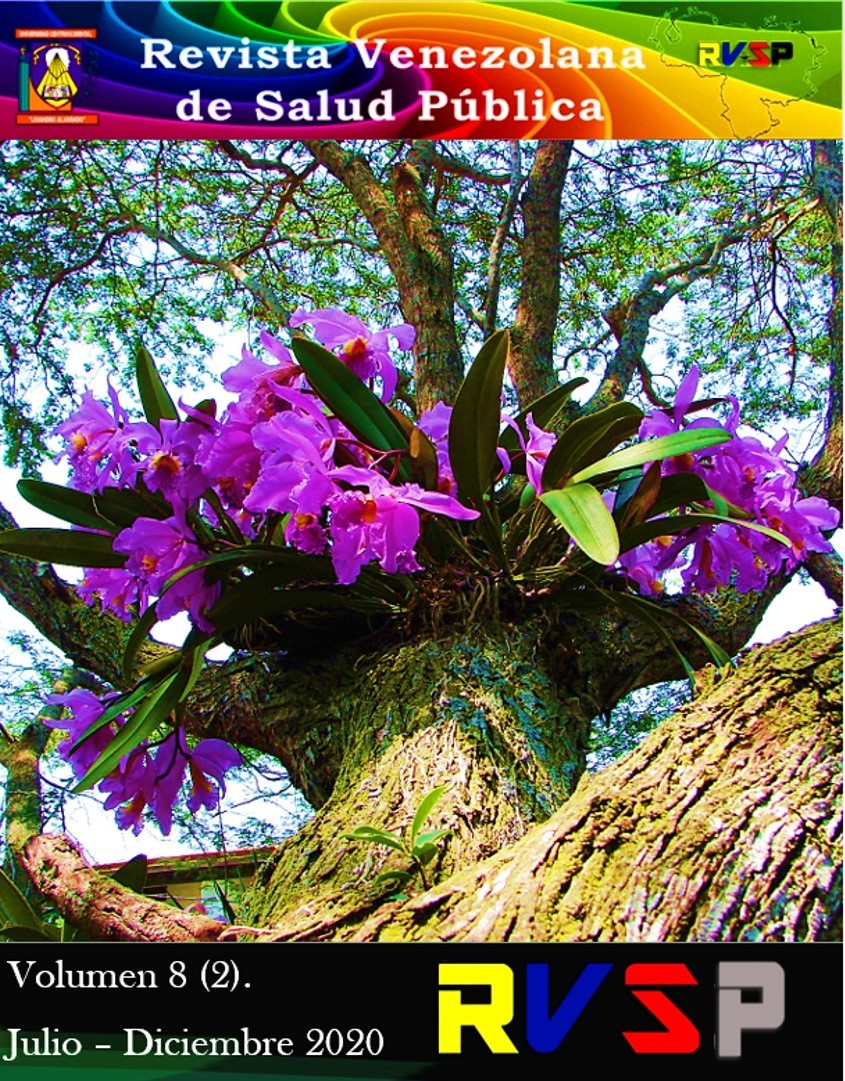Wild rabies as a public health problem in Lara state, 2007/2019 period
Keywords:
Epidemiological Surveillance, Zoonoses, Public HealthAbstract
The activities of human beings and their interaction with the environment as an adaptation process, these relationships have resulted in public health problems, due to land degradation, water scarcity, and zoonotic diseases, these are produced by the contact of an animal infected with the pathogenic species bacteria, parasites, viruses and fungi, between humans, animals and their environment causing endemics, epidemics and pandemics, in this case wild rabies is direct transmission through the mucosa of the eyes, nose, mouth or skin cut by the virus of the Rhabdoviridae family, due to ecological changes resulting from the interaction of these microorganisms, causing complex incidents affecting the most vulnerable population, causing great economic losses and serious damage to health public. In this context, the purpose of this study is to know rabies in Lara state, as it is an endemic state to wild rabies, the source of information was taken from the National Institute of Comprehensive Agricultural Health and the review of reports, for which it will be developed a description of its evolution and behavior from the period 2007-2019, for this reason this information is of great importance because it allows to have a historical count of positive cases for rabies in Lara state as a contribution that will contribute to the understanding of the illness.
Downloads
References
2) Frantchez V, Medina Julio; Rabia: 99,9% mortal, 100% prevenible Rev Méd Urug [Internet]. 2018; [citado marzo 2020]; 34(3):164-171 http://www.rmu.org.uy/revista/2018v3/art6.pdf doi:10.29193/RMU.34.3.5. Recuperado a partir de: http://www.scielo.edu.uy/pdf/rmu/v34n3/1688-0390-rmu-34-03-86.pdf
3) Rodríguez Ferri, E.F. Enfermedades Emergentes. Zoonosis Emergentes. En ‘‘Zoonosis. II Curso sobre Enfermedades Transmisibles entre los Animales y el Hombre” [Internet]. 2002; [citado marzo 2020]; págs 29-47. Recuperado a partir de: http://www.colvema.org/PDF/6279Zoonosis.pdf
4) Laval RE, Lepe IP. Una visión histórica de la rabia en Chile. Rev. chil. infectol. [Internet]. 2008 [citado marzo 2020]; 25(2): S2-S7. Recuperado a partir de: https://scielo.conicyt.cl/scielo.php?script=sci_arttext&pid=S0716-10182008000200014
5) Organización de las Naciones Unidas para la Alimentación y la Agricultura (FAO), Fortalecimiento del sistema de prevención y control de la Rabia Paralítica Bovina, mediante participación comunitaria bajo el enfoque "Una Salud". [Internet]. Enero 2016 [citado febrero del 2018]. Recuperado a partir de: http://www.fao.org/in-action/prevencion-rpb/resumen/es/
6) Widdowson M, Morales G, Chaves S, Mc Grane J. Epidemiology of urban canine Rabies. Santa Cruz, Bolivia, 1972 – 1997. Emerging infectious diseases. Vol. 8, No, 5, May, pp 458-460. Revista Electrónica de Veterinaria REDVET ISSN 1695-7504.VII, Nº09, [Internet]. 2002. [citado 2 de marzo de 2020]. 2 (1): 17-35. Recuperado a partir de: https://www.ncbi.nlm.nih.gov/pmc/articles/PMC2732486/
7) Organización Mundial de la Salud. 10 datos sobre la rabia. [Internet]. Septiembre (2017) [citado 22 de Febrero de 2020]. Recuperado a partir de: https://www.who.int/features/factfiles/rabies/es/
8) Gamboa-Reina AM. Descripción de la situación epidemiológica de la rabia humana y animal en Colombia entre 2008 y 2013. [Internet]. Bogotá, Colombia 2015, [citado 2 de marzo de 2020].Recuperado a partir de: https://ciencia.lasalle.edu.co/cgi/viewcontent.cgi?article=1108&context=medicina_veterinaria
9) Mariana I, Delgado J, Guillermo L, Florez M, Franger J, García A, Marjorie C, Machado S. Diagnostico Rápido de la Comunidad de Murciélagos del Parque “Negra Hipólita”: Fauna Sinantropica de la Ciudad de Valencia, Venezuela. Faraute Ciens. y Tec., [internet]. 2(2): 26-34, 2007 issn 1698-7418 depósito legal pp200402ca1617 [citado marzo de 2020]. Recuperado a partir de: http://servicio.bc.uc.edu.ve/facyt/v2n2/2-2-3.pdf
10) Lord RD. Guía Sobre Estrategias Ecológicas Para Controlar La Rabia Bovina. (1984).
11) Ministerio del Poder Popular para Agricultura y Tierra, Servicio Autónomo de Sanidad Agrícola, Instituto Nacional de Salud Agrícola Integral; (MPPAT- SASA-INSAI), Registros de Resultados de Diagnóstico Laboratorio de Rabia Sanidad Animal CENIAP-INIA, Maracay, estado Aragua y Laboratorio Zoosanitario Carora.2007- 2019.
12) Reportes de casos de Rabia, Sistema de Vigilancia Epidemiológica Zoosanitaria (SIVEZ) 2010 – 2019
Published
How to Cite
Issue
Section
Derechos del/de autor/es a partir del año de publicación
Esta obra está bajo la licencia:
Creative Commons Reconocimiento-NoComercial-CompartirIgual 4.0 Internacional (CC BY-NC-SA 4.0)
Las opiniones expresadas por los autores no necesariamente reflejan la postura del editor de la publicación ni de la UCLA. Se autoriza la reproducción total o parcial de los textos aquí publicados, siempre y cuando se cite la fuente completa y la dirección electrónica de esta revista. Los autores(as) tienen el derecho de utilizar sus artículos para cualquier propósito siempre y cuando se realice sin fines de lucro. Los autores(as) pueden publicar en internet o cualquier otro medio la versión final aprobada de su trabajo, luego que esta ha sido publicada en esta revista.



